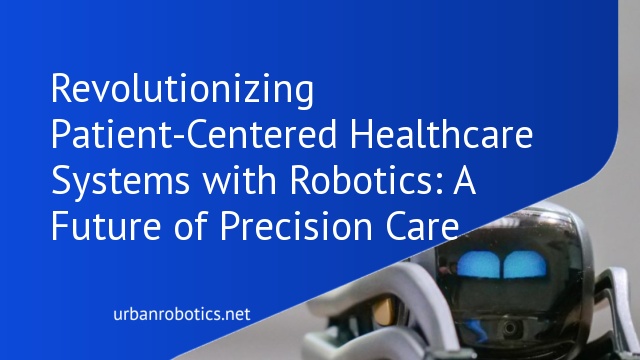Understanding Patient-Centered Healthcare
Patient-centered healthcare revolves around the individual needs and preferences of patients. It ensures that patients are active participants in their own care. Our approach integrates patients’ values and concerns into every healthcare decision. By focusing on holistic treatment, we drive better health outcomes.
Key elements of patient-centered healthcare include:
- Personalized Treatment Plans: Customizing care strategies based on patient-specific information, such as medical history and genetic profile, ensures more effective treatment.
- Enhanced Communication: Open and continuous dialog between patients and healthcare providers builds trust and transparency.
- Collaborative Decision-Making: Involving patients in their treatment choices promotes a sense of ownership and satisfaction.
- Comprehensive Care Coordination: Connecting different healthcare services and providers for seamless patient experience.
Advanced robotics further elevate patient-centered care. Robotics assist with precision and consistency in surgery, ensure accurate medication delivery, and provide support in rehabilitation. Overall, the integration of robotics in healthcare represents a significant advancement in crafting an environment where the patient’s holistic well-being is prioritized.
The Role of Robotics in Modern Healthcare
Robotics in healthcare is transforming patient-centered systems by providing enhanced precision, efficiency, and personalized patient experiences.
Types of Robotics in Healthcare
Several types of robotics help improve healthcare delivery:
- Surgical Robots: Used for minimally invasive surgeries, providing precision and control.
- Rehabilitation Robots: Assist patients undergoing physical therapy.
- Pharmacy Robots: Automate the dispensing and management of medications.
- Care Robots: Aid in patient monitoring and daily activities.
These robots enhance various aspects of patient care, ensuring improved outcomes and operational efficiency.
Benefits of Robotics for Patients
Robotics offers several advantages for patients:
- Increased Precision: Surgical robots reduce human error and improve recovery times.
- Enhanced Safety: Automated systems ensure accurate medication dispensing.
- Improved Rehabilitation: Therapy robots provide consistent, personalized physical therapy.
- Better Monitoring: Care robots offer continuous patient monitoring, ensuring timely interventions.
These benefits collectively create a more efficient, effective, and patient-centered healthcare system.
Integrating Robotics into Patient-Centered Healthcare Systems
Integrating robotics into patient-centered healthcare systems elevates the standard of care. Robotics enhance precision, efficiency, and personalization in treatment modalities.
Designing Patient-Centered Robotics
Patient-centered robotics align with the specific needs and preferences of patients. Engineers collaborate with healthcare professionals to ensure these robotic systems address real-world clinical challenges. For example, surgical robots offer enhanced dexterity for minimally invasive procedures. Rehabilitation robots facilitate tailored physical therapy sessions. Emphasizing the human aspect, the design process incorporates feedback from patients to optimize usability and comfort.
Implementing Robotics in Healthcare Practices
Implementing robotics in healthcare practices brings numerous operational benefits. Hospitals adopt surgical robots for precise and less invasive surgeries, reducing patient recovery times significantly. Rehabilitation centers integrate robots to deliver personalized therapy, enhancing patient outcomes. Additionally, pharmacy robots manage medications more efficiently, minimizing errors. Successful implementation requires training healthcare staff to operate and troubleshoot these advanced systems, ensuring seamless integration into daily practices.
Case Studies
Examining real-world applications provides valuable insights into how patient-centered healthcare systems with robotics are revolutionizing medical care.
Successful Implementations
South Korea’s Seoul National University Hospital has used robotic surgery systems to perform over 5,000 procedures with a marked reduction in recovery times. Johns Hopkins Hospital’s integration of robotic pharmacy systems has improved medication accuracy to 99.9%. Rehabilitation centers in Japan use tailored robotic physical therapy to enhance patient mobility and reduce recovery periods. These examples show how implementing advanced robotics can tremendously benefit healthcare outcomes.
Lessons Learned
Integrating robotic systems into healthcare isn’t without challenges. Seoul National University Hospital found that initial costs are high but justified by long-term savings. Johns Hopkins Hospital emphasized the need for continuous staff training to maintain high efficiency and safety. Japanese rehabilitation centers learned that patient feedback is crucial in refining robotic therapy systems for better usability. These lessons underline the importance of strategic planning, ongoing education, and patient-centered design in leveraging robotics for healthcare.
Future Trends in Patient-Centered Healthcare with Robotics
Advancements in robotics continue transforming the patient-centered healthcare landscape. Emerging technologies and potential challenges shape this continuous evolution.
Emerging Technologies
Cutting-edge robotics is revolutionizing patient care. Soft robotics improves patient interaction by offering more natural movement. AI integration in robotic systems enhances diagnostic accuracy, reducing errors. Exoskeletons aid in rehabilitation by enabling patients to regain mobility. Autonomous robots streamline hospital logistics by efficiently transporting supplies. Telepresence robots enable remote consultations, expanding access to healthcare professionals. Nanorobots promise targeted drug delivery, ensuring precision treatment.
Potential Challenges
Despite technological advancements, several challenges persist. High initial costs hinder widespread adoption in smaller healthcare facilities. Continuous training for healthcare staff becomes essential to fully utilize robotic systems. Concerns about data privacy arise with increased use of AI in diagnostics. Resistance from patients unfamiliar with robotic technology can slow implementation. Regulatory hurdles complicate the approval process for new robotic devices. Collaboration between policymakers, technologists, and healthcare providers is crucial to overcome these barriers.
Conclusion
Embracing robotics in healthcare promises a transformative shift towards truly patient-centered systems. By leveraging advanced technologies like AI integration and nanorobots, we can significantly enhance patient care and outcomes. However, the journey isn’t without its hurdles. High costs, training requirements, and regulatory challenges need to be addressed through collaborative efforts.
Our goal should be to create a seamless synergy between technology and human touch. As we move forward, continuous innovation and cooperation among all stakeholders will be essential. By overcoming these barriers, we can unlock the full potential of robotics in healthcare, ensuring a more efficient and compassionate healthcare system for all.





